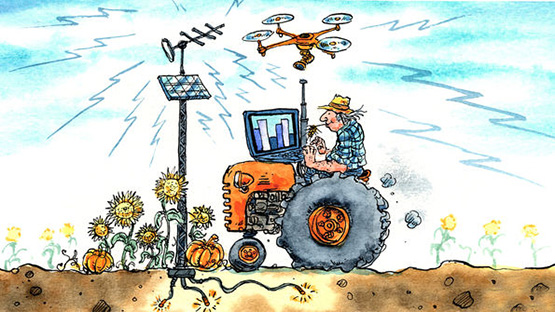Digital Horticulture

Fully adopting the digital revolution is
the key to long term success in horticulture
The domain of horticulture includes cultivation, plant propagation, breeding of plants, production of crops, plant physiology as well as biochemistry and genetic engineering. The plants looked at are mainly vegetables, trees, flowers, turf, shrubs, fruits and nuts.
Horticulturalists carry out extensive research in their domain in order to get better quality crop yields, improve their nutritional value to humans, make crops pest and disease resistant and adjust to environmental stresses.
As margins shrink, super efficient production systems are required to get the optimal results with the technologies applied. But, at some point you have to make a decision on whether to continue to be diversified - with different packing systems and growing expertise for each crop - or solely focus on what you do best.
Although many greenhouses are at the leading edge of energy management, utilizing the latest computer programs, double poly facilities, insulated walls, recirculating nutrient systems to minimize phosphorus production, aa well as energy curtains, more needs to be done to remain profitable.
”Digital Ag, or Precision Agriculture, is a farm management concept whereby growers need to measure and respond to inter-field and intra-field variability in crops, instead of treating every plant the same, in order to become C-neutral in farming and help avoid Climate Genocide.
Within a field, growers apply amounts of seed, chemical, or fertilizers to different areas, based on satellite imagery, crop sensors, soil variability or other metrics.
There is a flow of information:
Digi-Ag, aims to improve industry metrics such as yield, profit and sustainability, and to transform the sector’s commodity trading, purchasing of inputs, and tractability of products.
Three key technologies are currently changing the Digi-Ag landscape:
Blockchain technology solves supply problems quickly
Blockchain is an electronic ledger that can be used to capture, organize and validate data in almost every aspect of Digi-Ag. Blockchain technology is needed for correct IoT-based data collection. Blockchain technology should include contracts and certificates that can be executed by the blockchain.
Blockchain can make complex transactions that involve shipping paperwork, sanitation certification, and credit letters, etc., much quicker, cheaper, and easier to execute, which will benefit all parties involved.
Blockchain technology offers accurate and easy traceability of all produce from the exact spot where it was harvested to the retail outlet. Accurate accountability becomes quick and easy and appropriate action can take place instantly.
IoT for effective crop management
IoT technology, networks of physical devices that collect, connect and exchange data, are advancing Digi-Ag. When you measure metrics such things as plant-specific nutrient levels, leaf wetness, relative humidity, and photosynthetic active radiation in multiple spots in a field or shelf, you can actively manage crops.
Crop management decisions can be tailored to these micro-climates once they are identified. Edge computing and machine learning capabilities also need to be improved before data from IoT devices can be utilised to their full potential. Also, secured data storage can safely accommodate the large amount of data that IoT devices will generate.
Data storage platforms, the backbone of Digital-Ag
If all data from a group of indoor farms is accessible to all group members, then an expert analysis on the whole data set can be performed in order to realize maximum value for each participant.
That non-GPS data, obtained and processed on integrated platforms, should be owned by the group or cooperative and securely stored on its own integrated ‘cloud’ platform, so as to avoid theft and detrimental or 3rd party use of it. This also applies to the data infrastructure design and servicing.
Agricultural Big Data can be real property, personal property or intellectual property, depending on someone’s perspective.
Expertise is key for success in Digital-Ag.
Due to the complexity of the issues raised before, partnering with the right team that is experienced in creating technological solutions suited to very unique situations is the key to transform and then position a group or cooperative of indoor farmers to become leaders in their industry.